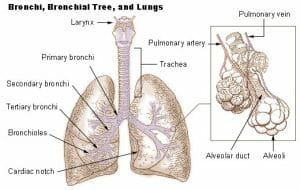Bronchioles Definition
The bronchioles are tubes in the lungs which branch off from the larger bronchi that enter each lung, from the large and singular trachea which connects to the mouth. As such, bronchioles are one of the smallest airways in the respiratory tract, and lead directly to the alveolar ducts which house the alveoli responsible for exchanging gases with the blood. These structures can be seen in the following image, with the bronchioles being labeled as number 5.
Each bronchus, after entering the lung near the number 2 in the image above, divides into secondary and tertiary bronchi, which get continually small. Eventually, the bronchi transition into bronchioles as they lose some of the structural elements that define a bronchus. The bronchioles lack hyaline cartilage, which surround the bronchi and keeps them from collapsing. Bronchioles are instead anchored to the tissues that they carry air to. Bronchioles are also supported by smooth muscle tissue, which surrounds each bronchiole. This smooth muscle tissue is sometimes prone to contract, reducing the size of the bronchioles. This is known as a bronchospasm, and is seen in patients with asthma and other lung diseases.
The bronchioles different units of the lungs, or pulmonary lobules. The bronchioles continue dividing into smaller terminal bronchioles, which divide into the smallest respiratory bronchioles. At the respiratory bronchioles, alveoli begin surround the bronchioles and the walls become thin enough that gas exchange can take place. The full structure of the respiratory tract can be seen below.
Function of the Bronchioles
The bronchioles serve as a transition between the large cartilage supported bronchi that enter the lungs and the tiny alveolar ducts that connect directly to the alveoli. The bronchioles carry oxygen rich air into the lungs and carry carbon dioxide rich air out of the lungs, thereby aiding in the processes of breathing and respiration. The smooth muscle that surround the bronchioles can constrict or dilate the airway, which can aid in getting the proper amount of oxygen into the blood.
Related Biology Terms
- Pulmonary Lobule – A functional unit of lung tissue containing tissue blood vessels and airways, which are fed by bronchioles.
- Bronchi – The large airways that branch off of the main trachea, and supply each lung with air.
- Hyaline Cartilage – Rings of a hard material, seen in several joints and in rings that surround the trachea and bronchi.
- Respiratory Tract – The entire system of airways which connect the mouth to the alveoli responsible for exchanging gases with the blood vessels in the lungs.
Quiz
1. When doing a dissection, what is the easiest way to distinguish between bronchi and bronchioles?
A. Dye them with special UV dye which will show the difference in the cells
B. Feel the airway with a gloved finger
C. Carefully remove the airway from the lung, and divide it into sections, then compare all sections


